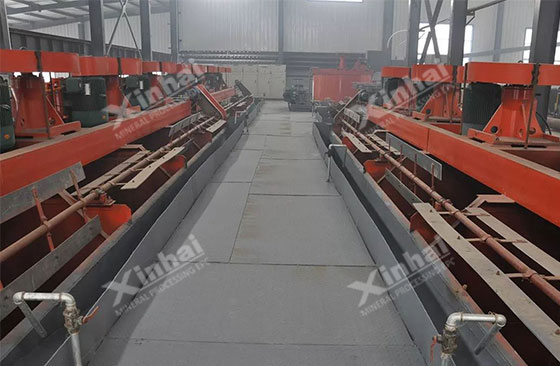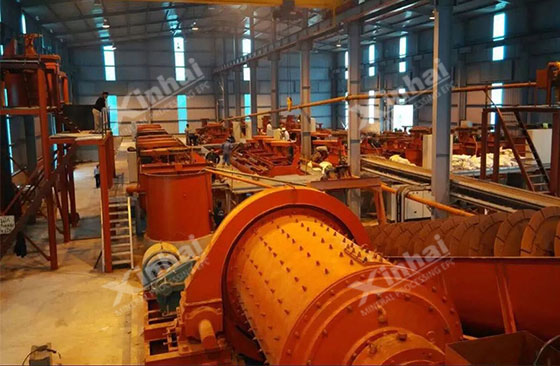
In flotation mineral processing, the flotation machine scrapes the foams with minerals, to separate the valuable minerals and gangue minerals. In this period, the foam pulp contains solid, liquid and gas materials. The process by which the mineral particles in the pulp adhere to the bubbles is called bubble mineralization.
The process of bubble mineralization has certain selectivity to ore particles. In this process, the hydrophobic ore particles adhere to the bubbles and form a gas-solid complex. Hydrophilic ore particles are difficult to adhere to the bubble, remain in the pulp. For the flotation process, the adhesion degree of ore particles on bubbles has a direct impact on the flotation effect, so improving the degree of bubble mineralization is one of the key factors to improve the flotation process effect.
How can we improve the flotation mineral process effect by improving the bubble mineralization process? The more important factors include bubble size, mineral surface properties, mineral particle density and particle size, etc. We will explore their role in influencing the flotation mineral processing effect from these aspects one by one.
In the process of bubble adhesion to mineral, the bubble and mineral particles are close to each other and collide with each other. Only after several collisions can the bubble capture mineral particles. At least ten collisions occur between the minerals and the bubbles during the phase in which the grains and bubbles are realized. Reducing the bubble diameter can increase the probability of the collision between the bubble and the mineral particles, so that the mineral particles are easier to adhere to the bubble, and the mineralization process is easier to carry out.
In production practice, the size of the bubble should be determined according to the size of the mineral particles. When the mineral particle size is fine, the bubble size can be appropriately reduced, but not too small, otherwise the recovery rate and concentrate quality will be reduced, so as to increase the collision probability between the bubble and the mineral, so as to improve the flotation mineral processing effect.

The mineral surface property here mainly refers to the wettability of the mineral surface, which determines whether the mineral can carry out selective adsorption, that is, whether the mineralization process can be completed. Generally, surface wettability is determined by the structural properties of minerals. The worse the surface wettability is, the stronger the hydrophobicity is, and the better the natural floatability of minerals is. For this mineral, bubbles easily displace the hydration film on the surface of the mineral, allowing it to adhere to the surface of the bubble in a stable manner, thus forming bubble mineralization.
In general, in the determination of mineral composition, the floatability of constituent minerals can be compared according to their different surface wettability. When the difference of surface wettability between useful minerals and gangue minerals is relatively small, we can enlarge the difference of floatability between them by adding suitable medium adjustment agent and collector, so that one of them can adhere to the bubble more easily, which is convenient for flotation mineral processing.

When the mineral attaches to the bubble, the bubble rises to the surface of the pulp and enters the foam product. The bubble capacity is limited, how to ensure that mineral particles do not fall off the bubble surface from the time they are attached to the slurry surface until they are scraped into the foam tank?
When the mineral particles adhere to the bubble, the forces on the mineral particles include the buoyancy of the bubble, the gravity of the ore particles themselves, and the adhesion between the mineral and the bubble. Therefore, in addition to the wettability of the mineral surface, mineral density and particle size are also important factors in this process. After analysis, it is not difficult to find that the adhesion and buoyancy of mineral particles should be greater than their own gravity when they rise to the foam layer. Therefore, for mineral particles, under certain gravity conditions, the smaller the density of the mineral, the larger the diameter of the mineral particles that can be flotation. Therefore, for minerals with poor wettability and low density, the grinding fineness of these minerals can be appropriately relaxed during flotation mineral processing, such as graphite, molybdenite and so on.

Above, we explained how the bubble mineralization influences the flotation mineral process from three aspects. In fact, the above factors are some controllable aspects, and there are many factors that can affect the flotation effect, such as the hydrodynamic morphology in the flotation machine, the mechanism of flotation agents and the right amount of addition. For some complex ores, in the development of the process, do not mechanically follow, according to its ore properties, through the test to determine the appropriate process and its parameters is a more scientific and reasonable means, you can consult the processing equipment manufacturers with the qualification of mineral processing test, the ore process, to avoid economic losses and resource waste.
1.Yunnan 4400tpd copper processing project

2.Pakistan 1500tpd copper processing project

3.Mexico 1500tpd Cu-Pb-Zn-Au-Ag multiple metal processing project

4.Shandong 1300tpd Mn-Wu processing project

5.Vietnam 800tpd graphite processing project

6.Uganda 720tpdd phosphate processing project

7.Morocco 500tpd silver processing project

To find out more about our products and solutions, please fill out the form below and one of our experts will get back to you shortly.